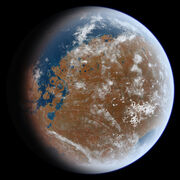
Small part of the Cydonia region, taken by the Viking 1 orbiter and released by NASA/JPL on July 25, 1976
Cydonia is a region on Mars that is comprised of unusual geological land formations. The Face on Mars and the D&M Pyramid can be found in this region.
Cydonia Mensae[]
  Figure 2 in The D&M Pyramid of Mars (1996), by Erol Torun  Pentagonal landmass coined “D&M Pyramid” |
The morphology of Cydonia Mensae is rather complex and not completely understood. The region exhibits evidence for previous epochs of cratering, erosion, and deposition, contributing to a wide variety of landform observations and surface types. The geology of Cydonia Mensae was first described by Guest, Butterworth, and Greeley.[1] The region shows a mixture of smooth and fractured plains, and a small to moderate amount of cratering. Most relief in the vicinity of the D&M Pyramid is composed of mesas, knobs, and smooth plains material. Mesas are most likely the remnants of an earlier surface type that was removed by erosion, leaving mesas of more resistant material. Knobs may have been formed in a similar fashion, perhaps from rough, heavily cratered terrain. The shape of some knob material appears to have been modified by mass wasting or slumping, perhaps driven by the freezing and thawing of ground ice, with the excess material carried off by wind or, under different climatic conditions, by water or glacial ice. Further evidence for some type of erosion is provided by the presence of several pedestal craters in Cydonia Mensae. A pedestal crater is an impact crater surrounded by an ejecta blanket that ends in a steep scarp that may drop hundreds of meters to the surface. The ejecta blanket is presumably composed of material that is more resistant to erosion than the surrounding surface.[2]
Acidalia Planitia[]

Artist's impression of ancient water on Mars theory
There is a hypothesis that the basin north of Cydonia called Acidalia Planitia was once a shallow sea[3] (See Water on Mars). There are features in the study area that are suggestive of lacustrine erosion, such as small craters with a "smudged" appearance that may at one time have been submerged and subject to shallow wave action. There are also some curvilinear features suggestive of lacustrine deposition.[2]
This would would also place the area of Cydonia Mensae under study near the former shoreline. Small craters in this area appear to have been modified by water erosion, perhaps by shallow wave action. This would match the observations of recent researchers that linear features in this area may be lacustrine deposits resulting from shallow wave action at the edge of an ancient sea.[3] The nearby D&M Pyramid, however, bears no resemblance to fluvial processes, as sharp edged multi-faceted symmetrical shapes are not characteristic of fluvial landforms.[2]
References[]
- ↑ J.E. Guest, P.S. Butterworth and R. Greeley, 'Geological Observations in the Cydonia region of Mars from Viking', J. Geophys. Res., 82, 4111-4120 (1977).
- ↑ 2.0 2.1 2.2 The D&M Pyramid of Mars (1996), by Erol Torun
- ↑ 3.0 3.1 T.J. Parker, D.S. Gorsline, R.S. Saunders, D.C. Pieri, and D.M. Schneeberger, 'Coastal Geomorphology of the Martian Northern Plains', J. Geophys. Res., 82, No. E6, 11,061-11,078 (1993).